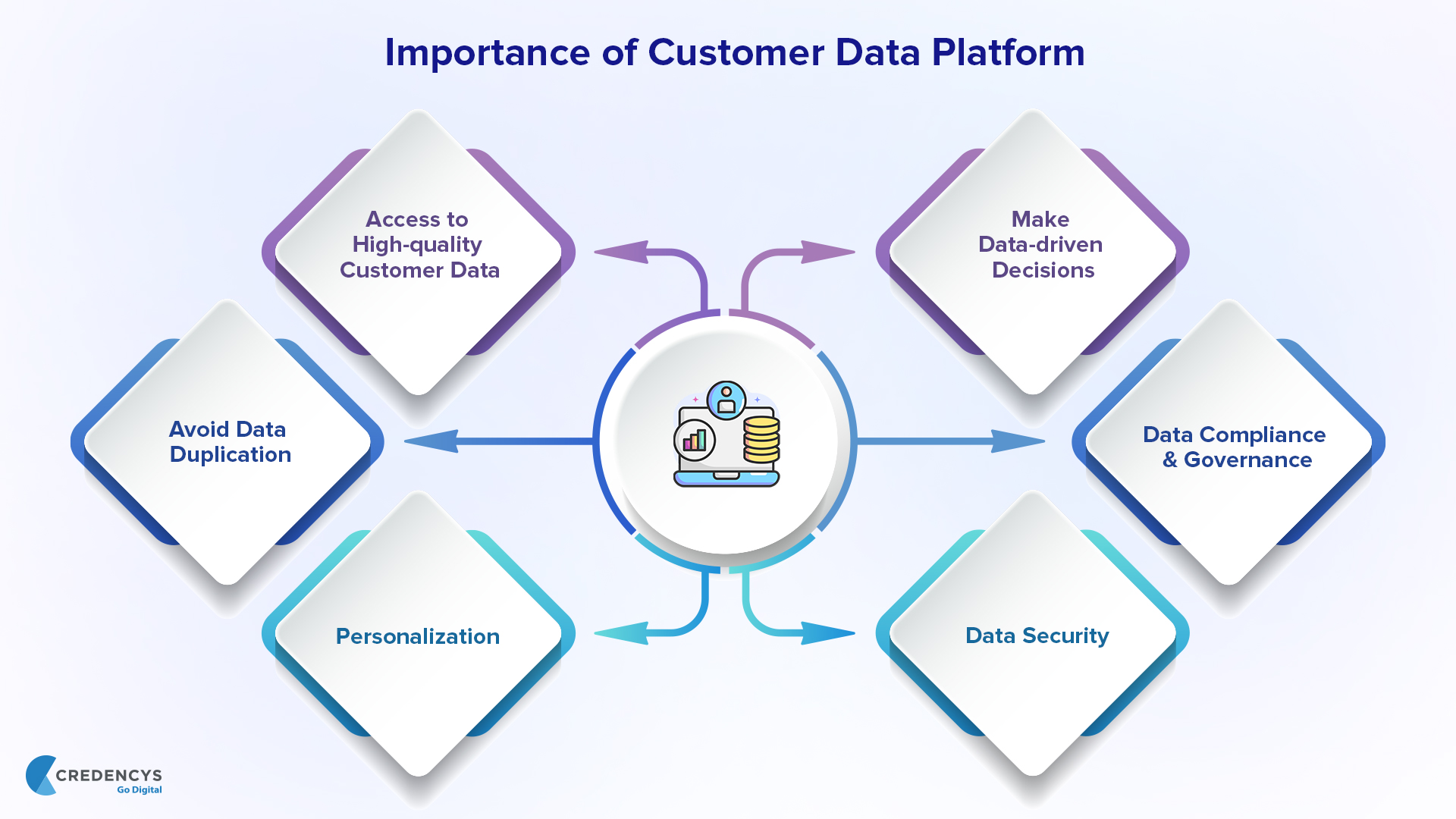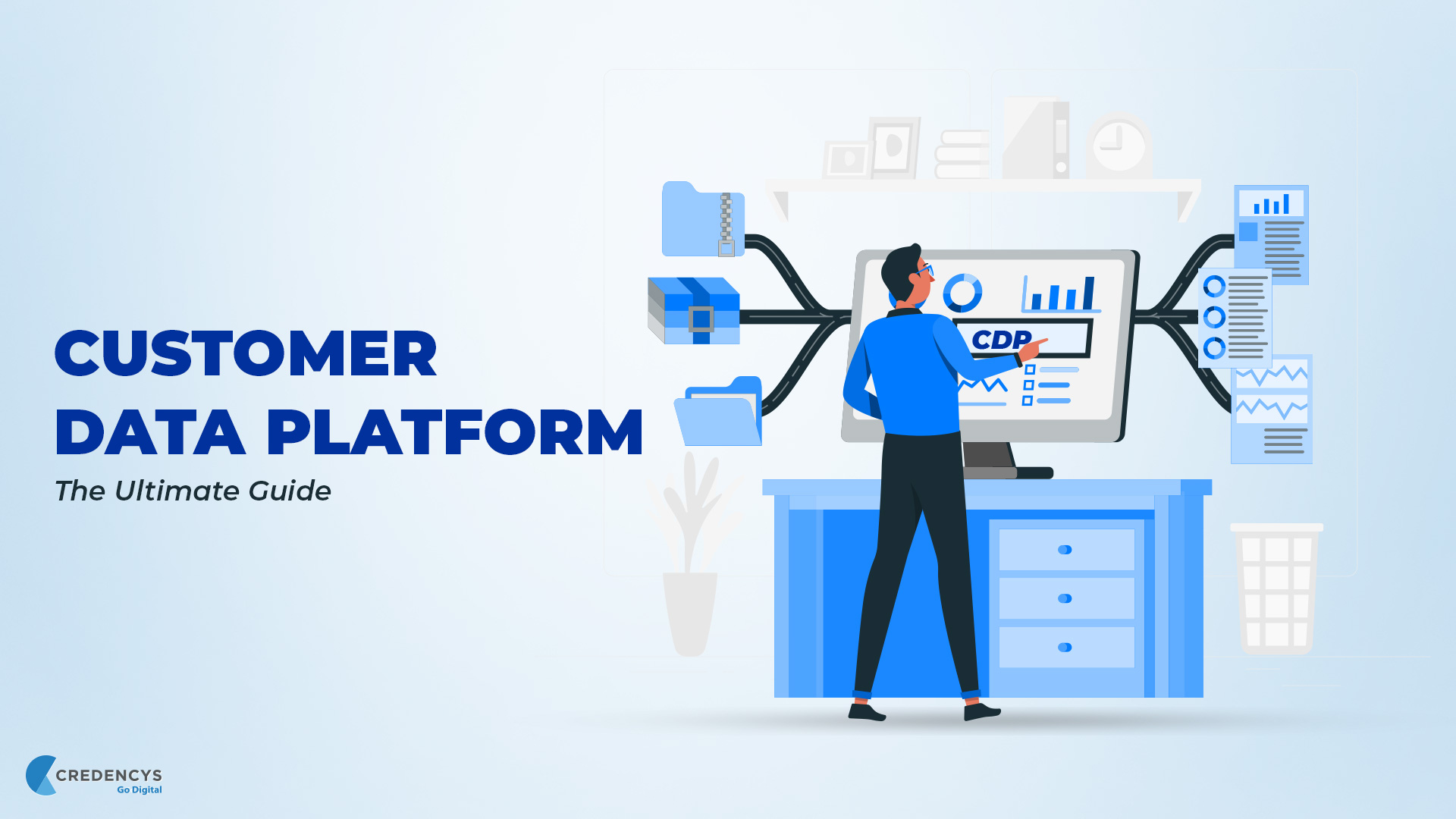Customer Data Platform: The Ultimate Guide
The growth and development of any business depend mainly on its customers and their feedback. The organization had to manage different types of data for their smooth functioning. Customer data is one of the crucial types of data that helps in product development and targeting. So, having a customer data platform becomes essential for companies these days. Through the customer data platform guide, you can explore the advanced capabilities of CDP.
Every customer is represented with the help of the magnitude of data points. These include the parameters like their age, personal taste, geographical location, basic demographic traits, browsing history, previous purchase details, social media interactions, etc.
These customers are complex individuals and it is essential for building a well-rounded customer profile with all essential data points, thus there is a need for a customer data platform.
- What is a Customer Data Platform (CDP)?
- Why Should Companies Give Importance to Customer Data Platforms?
- Business Benefits of Managing Customer Data in Customer Data Platform
- When Do You Need Customer Data Platform (CDP)?
- Types of Customer Data & Customer Data Collection
- Key Elements of Customer Data Platform
- Customer Data Platform (CDP) – Best Practices
- How To Choose the Right Customer Data Platform (CDP)?
- In a nutshell of Customer Data Platform Guide
What is a Customer Data Platform (CDP)?
The customer data platform allows for customer data management which is the process of acquiring, organizing, and utilizing customer-related data for understanding their customers, increasing conversations with them, enhancing customer retention, and providing them with the most relevant customer experience.
CDP allows for the collection and analysis of this customer data, data security measures, ethics of customer data acquisition, etc.
First-party Customer Data
The customer data includes the first-party data that is directly collected by the company from the customers based on their interests and behavior. It helps in creating a trail for tracking where the data came from. The other type of customer data includes the zero-party data that the customer proactively and intentionally shared.
Second-party Customer Data
The second-party data includes the data collected by other companies and sold or shared with the non-competitive partner. The third-party data includes data gathered by the data collection company and usually has low-quality data. The customer data platform helps in collecting the data and enriching its quality.
Why Should Companies Give Importance to Customer Data Platforms?

The main reasons for any organization to give importance to customer data platforms are the benefits gained by its implementation. The key benefits of implementing customer data platforms include:
- It provides high-quality customer data that is useful and maintains the accuracy and cleanliness of data.
- It avoids data duplication thus reducing the wastage of cost and time involved in rectification.
- Improves personalization and targeting that will help in boosting customer engagement and customer retention.
- Empowers businesses by enabling them to make data-driven decisions.
- It helps the business to stay compliant with data regulations.
- It enables the protection of the business from data loss, theft, breaches, etc.
Business Benefits of Managing Customer Data in Customer Data Platform
Customer data helps businesses in many ways, particularly in building effective marketing and sales campaigns. Managing the customer data with a perfect management strategy will help companies to improve their overall processes, services, and products.
Here are the lists of a few valuable benefits a company can get through an effective customer data platform.
- Helps to increase customer acquisition.
- Offers more opportunities to do up-sell and cross-sell across multiple channels.
- Builds customer loyalty, customer lifetime, and customer retention.
- Helps marketers to create effective marketing campaigns.
- Better customer satisfaction.
- Offer a competitive edge through personalization.
When Do You Need Customer Data Platform (CDP)?

If you are running a business, then you should be aware of when to have a customer data platform. Directors and business decision-makers who are aware of advanced technology would well know when to introduce a CDP.
Having a good CDP will act as a one-stop solution for a business to improve customer experience, improve marketing efficiency along by improving sales campaign effectiveness.
Here are the lists of some key indicators that tell your business needs the right customer data platform.
Having Exceptionally Large & Siloed Data
In general, when a business dealing with direct customers (B2C) will always have a large volume of data vertically. On the other hand, business-to-business (B2B) will have a large volume of data horizontally.
It doesn’t matter whether it’s B2B or B2C, once the business starts to expand, managing those data gathering and data storage would be a daunting task especially in making it error-free. This will have a direct negative impact on the marketing and sales team. If your business is experiencing such issues, then it’s time to go for CDP.
Personalization
Businesses around the world are forced to be innovative and do something attractive to gain the attention of the target audience. Also, such initiatives will help businesses to sustain themselves in the competitive market.
Companies worldwide strongly believe delivering personalized content will attract more customers and increase the sales ratio significantly. Also, personalization will increase the customer lifecycle and improve customer experience with the brand; this will eventually increase the up-selling and revenues.
At the same time, the quality of personalization strongly depends upon the data quality. So, it becomes essential for companies to bring CDP into their business operation.
Omnichannel Experience
Modern consumers around the world are seeking more from the brands to keep them engaged. They would prefer brands that allow them to reach from multiple channels. So, companies need to deliver an omnichannel experience to their consumers.
At the same time, they should be aware of being fully equipped with the right data and technology to deliver quality content consistently across multiple channels. Having a good customer data platform will make things easier for companies in this area. Also, the CDP makes sure all the channels receive quality data uniformly without any siloed data.
Types of Customer Data & Customer Data Collection
A customer data platform involves the use of different tools and strategies for the collection of data and it depends on the type of data. There are different types of customer data and data collection and these include:
1. Top-of-funnel customer data
The data collected by using this top-of-funnel lead includes low-effort and low-consequence information like email, name, etc. It allows for collecting general information mainly the unqualified and irrelevant leads. This data collection is performed in the following ways:
Implementing the inline or embedded webpage buttons
This data is useful for testing the effectiveness of downloadable resources, email campaigns, etc. This data collected helps in encouraging the website visitors for signing up for free product trials, newsletter subscriptions, downloading templates, e-books, and other digital resources, etc., Speak with representation for more details, watching of product demos, etc.
Pop-up or slide-in lead-generation forms
This is an aggressive method for customer data collection and is automated by customized triggers like:
Time of page
When a visitor stays on the web page for at least one minute,
Exit
When a visitor initiated the process of leaving the web page by hovering over the close button of the browser.
Entrance
The minute the visitor lands on the webpage, this data can be used for identifying potential customers.
2. Bottom-of-funnel customer data
This type of customer data is valuable for qualifying and converting prospects as there are customers that are already interested in the products or services. For maximum utilization of data, it includes the use of landing page forms.
These are used for promoting the product or service by describing what it includes and what the customer has to expect from it. The customer data is directly exported into the CRM for safekeeping and future reference.
3. Current customer data
This data is useful in improving existing products, developing new ones, and providing better customer services. This is high-value data and leads to an increase in revenue, enhanced customer understanding, improved customer retention, etc. This can be done by using questionnaires, feedback forms, follow-up phone calls, etc.
Key Elements of Customer Data Platform

Marketing is always customer-centric, which is why marketers are building their campaigns to deliver a personalized experience to their customers. At the same time, to build an effective marketing campaign, marketers would need robust and reliable data at every customer touchpoint. This is where the customer data platform framework comes to play.
Having a well-defined CDP framework will always help companies by acting as a single source of truth for data. It delivers well-optimized quality content to multiple channels consistently. In addition, the elements CDP framework helps businesses to offer real-time and data-driven responses to their customers.
In this customer data platform guide, we have provided you with a list of 4 key elements of the CDP framework.
1. Data Collection & Integration
Data collection and data integration is the first and foremost step of the CDP strategy. A new age business receives millions of data from thousands of data touchpoints from various channels/devices/platforms.
All that data needs to be collected and transformed into a uniform format with perfection. This is where the customer data platform strategy plays a key role in handling those large amounts of data effectively.
2. Data Management
It is a phase in which the CDP connects all the dots of the related data which are collected from various sources. In data management, CDP systems undergo processes such as probabilistic identity resolutions, filling all the gaps in data identity graphs, offering sufficient data to create a 360-degree customer profile, and so.
All the processes involved in the data management segment of CDP make sure all the customer data complies with the rules.
3. Data Analysis
It is a stage where CDP offers the data which can be ready to use. Using the data provided by CDP will help marketers to build a look-like customer profile, and to run predictive analyses.
For analysis, the data intelligent system can also be used to assist in data customization for customer interactions and experiences.
4. Data Activation
Even though all data are collected and stored in a unified place, that doesn’t mean that those data are activated enough to be used for marketing campaigns. This is the final stage where the CDP strategy will tell how data to be used or run in data-driven marketing campaigns.
Visit How Does A Customer Data Platform Help to Transform Your Business? to understand the essence of CDP. It helps companies drive operational efficiency and customer engagement in our business.
Customer Data Platform (CDP) – Best Practices

Effective CDP has great potential for maximizing the business in many ways. The best practices for customer data platforms include:
Training of employees
The organization should consider providing training for their employees for effective handling of the data. The employees should have practical experience in data analysis.
This will help them better understand the concept data on a comprehensive level and lead to the creation of a complete analytical report. It will help in creating data-centric strategies for the growth of the business through effective data management.
Use of validation tools
The customer database includes vast data and it is essential for using validation tools. The best results are obtained when the organization implements the integration of the leading validation software with the popular CRM and ERM systems for efficient functioning.
Appoint data control
The organization should divide the analysis into several departments providing full administrative privileges to a handful of employees. Taking utmost precautions will lead to running into a lesser risk of dealing with non-common data.
Data monitoring
Customer data is always changing thus it is important to employ solid data monitoring principles. Implementing various techniques will help in maintaining the overall quality of the data and establishing security policies for keeping the data organized.
Performing the bi-weekly scans will help in the detection of incomplete and erroneous records for data optimization. Implementing the use of an online report generator will reduce the time involved and also enhance the quality of the data monitoring process.
Focus on relevant data for relevant results
Customer data includes large data and sometimes it is important to use all the available customer data for making sound decisions.
If the data is required for addressing the sales of the product, the analytical team can focus on the sales report to avoid data overload. This will help in providing better quality information over the data quantity.
Avoid data fragmentation
It is necessary for using a wide selection of customer data through the implementation of a cohesive information collection process. Using smaller tools and platforms will lead to the collection of less effective and fragmented data.
Thus, it is essential for ensuring cohesion and fluidity to access larger data coverage for collecting the most valuable details.
Data visualization
Visualizing the customer data with the help of online data visualization tools will help in getting insights from the overall information. It will help in providing a real-world perspective for enhancing the customer experience leading to increased commercial success.
How To Choose the Right Customer Data Platform (CDP)?

In the customer data platform guide, we have covered key points to consider while choosing the right CDP. It includes
1. Establishing a working team
It is important to understand the stakeholders. The working team should include the team that already collects the customer data. It will also include data from the CRM system, and DMP and also involves working with the internal IT team.
For the proper functioning of the CDP, it is essential to have improved communication and coordination with the different teams within the organization.
2. Defining the needs
Understanding the need for CDP is very essential thus it is important to discuss with the stakeholders for knowing the needs and then delivering the details will make it easier for getting compliance.
Focus on model cases like the personalization of the digital customer experience, provided enhanced loyalty, concern over data privacy management, etc.
3. Gathering requirements
The use case will help in defining the required features and functionalities in the CDP for achieving the goals and objectives. One can define the requirements during the process set up to ensure addressing the use case without requiring extensive modifications.
Incorporating cross-organizational projects will help in including the more relevant groups for enhancing the process.
4. Understanding vendor
The selected CDP use cases and requirements will allow in providing the roadmap for the types of vendors to look for. It is necessary to understand that not all the CDP vendors will provide all purpose-built for managing the central data management platform.
It is important to check for the purpose-built enterprise-grade use cases that will have enhanced functionalities. The CDP should be future-proof to ensure it will evolve with the tech stack and thus it should be built from the ground up.
5. Roles, skills, and processes
Along with the deployment of the CDP, the organization can identify the right people with the required skills and processes. The main requirements include digital marketing with the marketing technology professionals for running the CDP and using its insights for optimized campaigns.
The organization will also need a data analyst and data scientist for the evaluation, integration, and management of the data. The team will also need the IT professionals for initial setups and integrations and further continued support for the ongoing campaign customizations and integrations.
In a nutshell of Customer Data Platform Guide
Customers are the key players in any business and it is essential to place them in the center and front. Every organization needs to implement a customer data platform for data accuracy and uniformity that will help in aligning the essential data for business growth, inspiring the marketing team, and engaging the customers for the development and growth of the brand and business.







Tags: